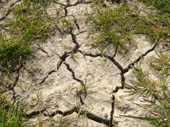
Purpose
To demonstrate the devastating effects of soil erosion and its impact to the world's agriculture.
Additional information
Erosion is the wearing away of soil and rock, and the down-slope movement of soil and rock. Some factors that influence erosion include gravity, glaciers, water, wind, ice, and waves.
During the process of erosion, chemicals from farming which are contained in the soil, are washed into our waterways, causing pollution. Soil erosion is a worldwide environmental problem with up to 80% of the world's agricultural soils affected. It takes a long time for soil to form from the breaking down of rocks and organic matter. Without soil plants can't grow. Soil must be protected from erosion to preserve our futures.
Sponsored Links
Required materials
- 3 pans or plastic containers
- Pitcher of water
- 3 cups of sand
- Styrofoam cup
- Pen or pencil
- Journal (to record results)
- Tissue
Estimated Experiment Time
About 30 minutes.
Step-By-Step Procedure
- 1. Lay your three pans about 6 inches apart.
- 2. Pour one cup of sand into the middle of each pan.
- 3. Shape two piles of sand into small mountains in the center of the pans. Smooth the third pile of sand so that it covers the whole area of the pan (you may need more sand for this).
- 4. Predict what you believe would happen if rain fell on one of your mountains and what would happen if it fell on the flattened sand. Write your predictions in your journal.
- 5. Make a small hole in the bottom of your Styrofoam cup. Place your finger over the whole and fill the cup about one-half way with water from the pitcher.
- 6. Hold the cup approximately 12 inches above the center of your smooth pan. Move your finger so that the water trickles out through the hole of the cup. When the cup has emptied, set it aside and record the results of what happened to the sand in your journal.
- 7. Repeat the same procedure in step 6, but this time on one of the pans with the mountain of sand. Don't forget to fill the cup one-half with water and hold it 12 inches from the center of the mountain. Record the results of what happened to the mountain in your journal.
- 8. Cover your second mountain (the third pan now) with your tissue. The tissue will represent the plants and brush that would grow on your mountain. Fill your cup one-half with water and let it trickle out above the tissue-covered mountain until the cup is empty. Again, record your results in your journal.
Note
If you don't happen to live near a beach, you can actually buy the sand! Most pool and sporting good stores carry sand that is often used to weigh objects down.
Observation
How did the shape of the land influence the amount of erosion that took place? How did the tissue covering the mountain affect the rate of erosion? Of the three pans, which one resulted in the most erosion? Which resulted in the least?
Result
The sand formation with the tissue demonstrates how the trees, brush, and natural occurring elements help to form a bond on the earth. They protect the soil from rapid erosion, acting almost like a glue that keeps the earth together. Without these elements present the soil erodes at a much quicker pace.
Sponsored Links
Take a moment to visit our table of Periodic Elements page where you can get an in-depth view of all the elements,
complete with the industry first side-by-side element comparisons!